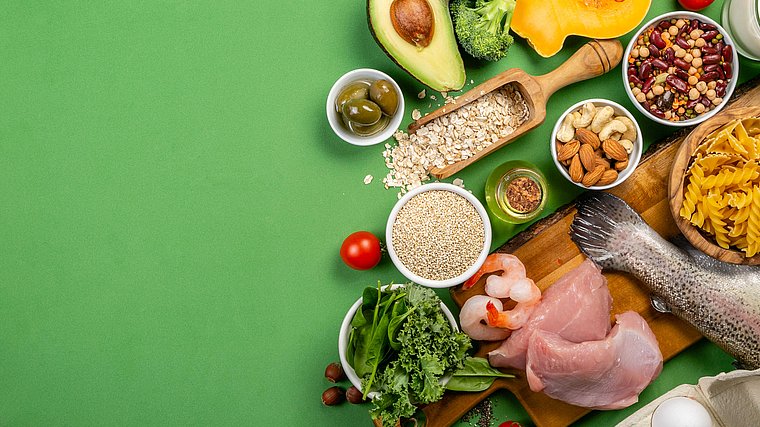Did you know that hypertension is a widespread, chronic, civilisation disease that affects an average of 30 percent of the adult population? In order to protect oneself from this disease and its complications, it is advisable to make lifestyle modifications, especially changes in eating habits. The DASH MultiLife Diet will be a great start to a new, healthy life.
Who is it for?
The DASH diet is considered one of the healthiest dietary models in the world! And while it was initially aimed mainly at hypertensive patients, its use has expanded over time. Indeed, it turned out that far more groups could benefit from implementing its few simple principles.
DASH is the most commonly recommended diet plan for people with cardiovascular diseases (the aforementioned hypertension, atherosclerosis, ischemic heart disease, varicose veins, etc.), but also for those with diabetes, obesity, or metabolic syndrome. It will also work well in the prevention of type 2 diabetes, neurodegenerative diseases, as well as cardiovascular diseases or cancer. Because DASH significantly lowers “bad” cholesterol, it reduces the risk of atherosclerosis, heart attack or stroke.
Key principles of the MIND diet
Creators of the DASH diet recommend eating specific amounts of products from selected food groups to make it easier to follow. Its basis includes:
- Vegetables and fruit – they should be consumed in the amount of 4-5 servings per day with the predominance of the former (1 serving = 1 cup of leafy vegetables / ½ cup of cut, raw or cooked vegetables / 1 medium fruit). Among others, they provide fibre, folic acid and potassium, and are low in sodium. The fibre contained in them, especially its soluble fractions, has the effect of increasing the excretion of bile acids and cholesterol, and thus lowering their concentration. Vegetables and fruit are also a source of antioxidants (vitamins E and C, carotenoids and flavonoids), which have antioxidant effects and inhibit the oxidation of LDL cholesterol, one of the first steps in the development of atherosclerotic plaque.
- Whole grain cereal products – you should consume 6 to 8 servings per day (1 serving = 1 slice of bread or ½ cup of cooked pasta, rice, groats). They are a source of magnesium, fibre, as well as B vitamins. Especially rich in them are groats, which are a very practical product in the kitchen — they allow you to create many interesting dishes. They can be used for both savory and sweet dishes. The tastiness of meals which include groats makes it easier to stick to the set plan, which in turn translates into an improvement in blood pressure levels along with well-being.
- Reduced-fat dairy products – the recommended number of servings is 2-3 per day (1 serving = 1 glass of milk, yoghurt). Low-fat milk (0.5-1.5% fat) and dairy products are a source of complete protein, as well as calcium, which lowers the tension of the muscular blood vessels, and thus blood pressure.
- Fish and poultry – meat consumption should be limited to two servings per day. Choose lean poultry meat (without skin) – it is rich in protein, B vitamins, iron and zinc, while low in cholesterol and saturated fatty acids. Fish should be consumed a minimum of 2 to 4 times a week. It is especially worth reaching for oily sea fish, which are a source of omega-3 fatty acids that have anticoagulant and anti-inflammatory effects. Other sources of fat, such as oils, should make up 2-3 servings in the diet (1 serving = 1 teaspoon of olive oil or oil).
- Dry pulses and nuts – have them 4-5 times a week (1 serving = 1/3 cup of nuts / 2 spoonfuls of peanut butter / 2 spoonfuls of seeds / ½ cup of cooked legumes). They are a source of fibre, protein, magnesium and potassium. Nuts also provide essential unsaturated fatty acids.
What to limit?
- Red and processed meat, which is a source of saturated fatty acids and cholesterol. These compounds negatively affect the lipid profile, and thus increase the risk of hypertension and cardiovascular diseases.
- Sweets, as well as sugary drinks – these products should be consumed occasionally, due to their content of simple sugars and saturated fatty acids and trans fats.
- Salt – the best effects of the DASH diet are observed while limiting salt intake to 5-6 g (2,300 mg of sodium), or even to about 4 g (1,500 mg of sodium) per day. What can it be replaced with? Spices and herbs. Avoid processed products, as they are the ones that contain the highest amounts of sodium. It is better to go for natural, low-processed foods, and rinse canned products under running water.
What am I going to eat?
The DASH plan on the MultiLife platform focuses on limiting fried foods, eliminates egg-based dishes, fatty cuts of meats and their products, and includes meals rich in antioxidants, such as salads, vegetable pastes, oatmeal, millet groats or smoothies full of fruit and nuts. Among the ingredients, you’ll find lean dairy, sea fish and legumes with plenty of colourful vegetables. The DASH menu is diverse and very tasty!
References:
- P Saneei, A Salehi-Abargouei, A Esmaillzadeh, L Azadbakh. Influence of dietary approaches to stop hypertension (DASH) diet on blood pressure: a systematic review and meta-analysis on randomized controlled trials. Nutr Metab Cardiovasc Dis 2014; 24(12):1253-61
- Koloverou E et al. The effect of Mediterranean diet on the development of type 2 diabetes mellitus: A meta-analysis of 10 prospective studies and 136,846 participants. Metabolism 2014; 63(7):903-911
- Esposito K et al. Prevention and control of type 2 diabetes by Mediterranean diet: a systematic review. Diabetes Res Clin Pract 2010;89
- Hossein Farhadnejad, Mina Darand, Farshad Teymoori Farshad Teymoori et al. The association of Dietary Approach to Stop Hypertension (DASH) diet with metabolic healthy and metabolic unhealthy obesity phenotypes. Sci Rep 2019; 9(1):18690
